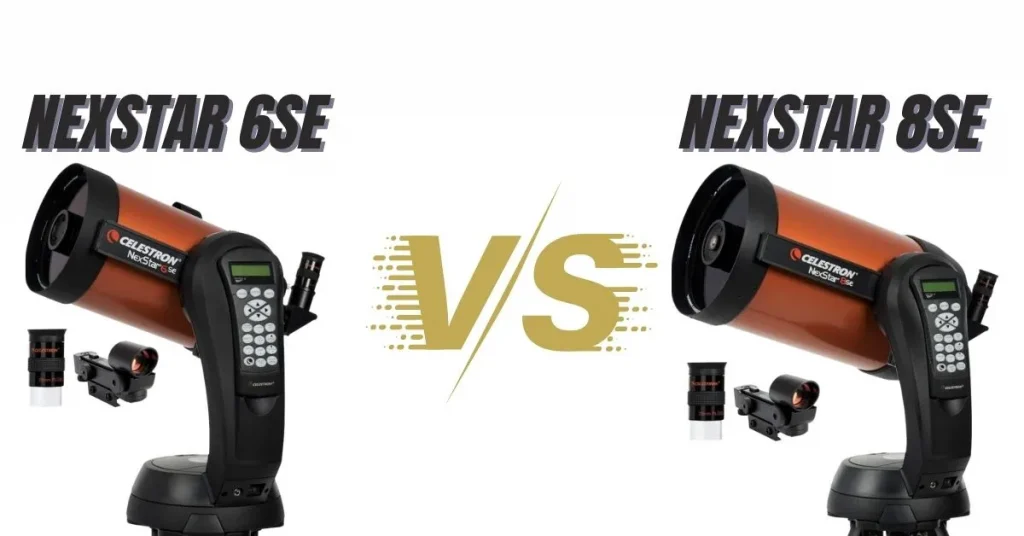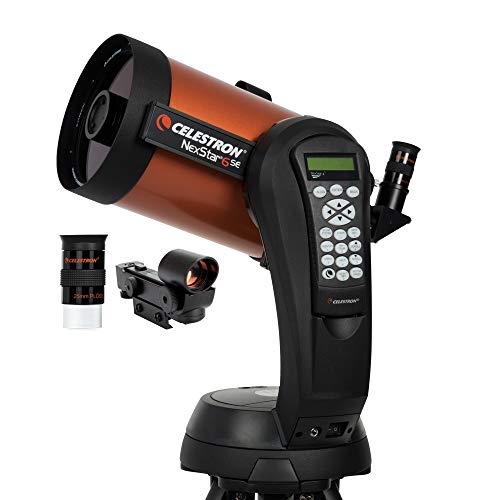Introduction
If you’re new to the world of telescopes, Nexstar would be a good place to start your search. Nexstar 6se and 8se are the best choices for telescopes.
Now you must need clarification about which one to go for. We’ve got your back to help you make the decision!
So, which one’s better Nexstar 6se vs. 8se?
Well, 8se would offer you the optics with superior quality. Moreover, you would also get a wide range of magnification in 8se. But the one with a lighter weight is 6se. Also, 6se would also be convenient with the size and tube length.
You must be eager to know the details of their differences so you can make your choice. We have just what you’re looking for in our article. So please give it a read!
Sounds about right? Let’s get started!
Nexstar 6se vs 8se: Fundamental Differences
Before we go to the detailed comparison, let’s look at the table below so that you get a basic idea about the difference in their features.
| Feature | Nexstar 6se | Nexstar 8se |
| Optics | Good | Superior |
| Magnification | Average Range | Wide Range |
| Weight | Light | Average |
| Size And Tube Length | Convenient | Average |
Nexstar 6se vs 8se: Head To Head Comparison
The basic differences may have given you an idea, but it’s merely enough to make a choice. Hence we’ve brought you the details right here. So, let’s see the comparison in detail below-
Optics
The NexStar 6se’s optics are comparable to those of the NexStar 8se. In truth, they have a lot in common regarding optics. And their alignment issues can be fixed just like the Celestron.
This number is usually obtained by dividing the focal length by the aperture. However, compared to the 6se, the 8se’s optics are significantly superior. As a result, the 8se outperforms the 6se in terms of deep-sky gazing.
Because of its restricted field of view and high focal ratio, the 6SE is limited. This could be better for focussing on small details. You can see anything down to magnitude 14 with this aperture size.
Magnification
The NexStar 6se follows the same design principles as the NexStar 8se. The 8se, on the other hand, has better magnification. On eyepiece 1, the 6se uses a typical 6OX magnification, with the lowest practical magnification of 21.
Hand control issues are also noticed at times. But don’t worry; you can fix it in no time.
With a magnification of 354X, it is one of the highest useful magnifications. In comparison, the 8se has a base magnification of 81X, 29X, and 480X. These are the lowest and maximum magnification capabilities that can be beneficial.
Weight
Regarding telescopes, the larger the aperture, the more powerful the device. Larger and visibly heavier are the most advanced telescopes for deep-space gazing.
The Celestron NexStar 6se weighs 30 pounds, which is a little considering the functions it offers. This makes it very simple to use for beginners. Similarly, the Celestron NexStar 8se weighs 33 pounds, slightly more than the 6SE.
However, it’s still portable and easy to move around for an extended period. But the weight difference is apparent.
Size And Tube Length
You may think that the telescope is made up of numerous components. And this is what varies its size. Changes in these components result in size changes.
In comparison to the NexStar 8SE, the NexStar 6se is slightly smaller. It has a 16-inch tube, a 7.1-inch diameter, and weighs 8 pounds.
On the other hand, the optical tube on the 8se is 17 inches long. And it is 9.1 inches in diameter. And it weighs 12 pounds. These variances also play a role in the various weights mentioned before.
Nexstar 8se has a tube length similar to the Japanese vintage binoculars.
Which One To Choose?
Well, you should be able to make up your mind by now. But if you’re still confused, let us give you a helping hand.
If you want superior optics and better magnification, go for 8se. But if portability is what you’re looking for, 6se is your telescope!
FAQs
Question: What can be observed with the Nexstar 6se?
Answer: The NexStar 6SE telescope is a Schmidt-Cassegrain-style scope that is portable, powerful, and easy to operate. Everything from the Moon to the planets can be observed with it. In addition, it may be used to keep deep-sky objects such as stars, galaxies, and nebulae.
Question: What can be observed with the Nexstar 8se?
Answer: You may expect to witness magnificent views of the Moon with the NexStar 8SE. Not only that but several planets may also be seen. The huge Orion Nebula, Jupiter, Saturn, Venus, and Mars, can be viewed. You will get access to the majority of our solar system. You can also dive into deep-space objects if the conditions are favorable.
Question: Why is there sometimes an issue keeping the focus?
Answer: The star diagonal is used by many refractors to bring the eyepiece inside the telescope’s focusing range. As a result, you may need help to focus on things. In that scenario, could you ensure the diagonal between the eyepiece and the telescope is constantly in position? The Moon should have a sharp edge, and the stars should focus on a single point.
The Final Words
Well, that was our take on the difference between Nexstar 6se vs. 8se! We believe the information we’ve provided is quite helpful in evaluating the products.
However, remember that your opinion can always be different from ours.
Best wishes!
Celestron - NexStar 6SE Telescope - Computerized Telescope for Beginners and Advanced Users - Fully-Automated GoTo Mount - SkyAlign Technology - 40,000 plus Celestial Objects - 6-Inch Primary Mirror
$899.00




